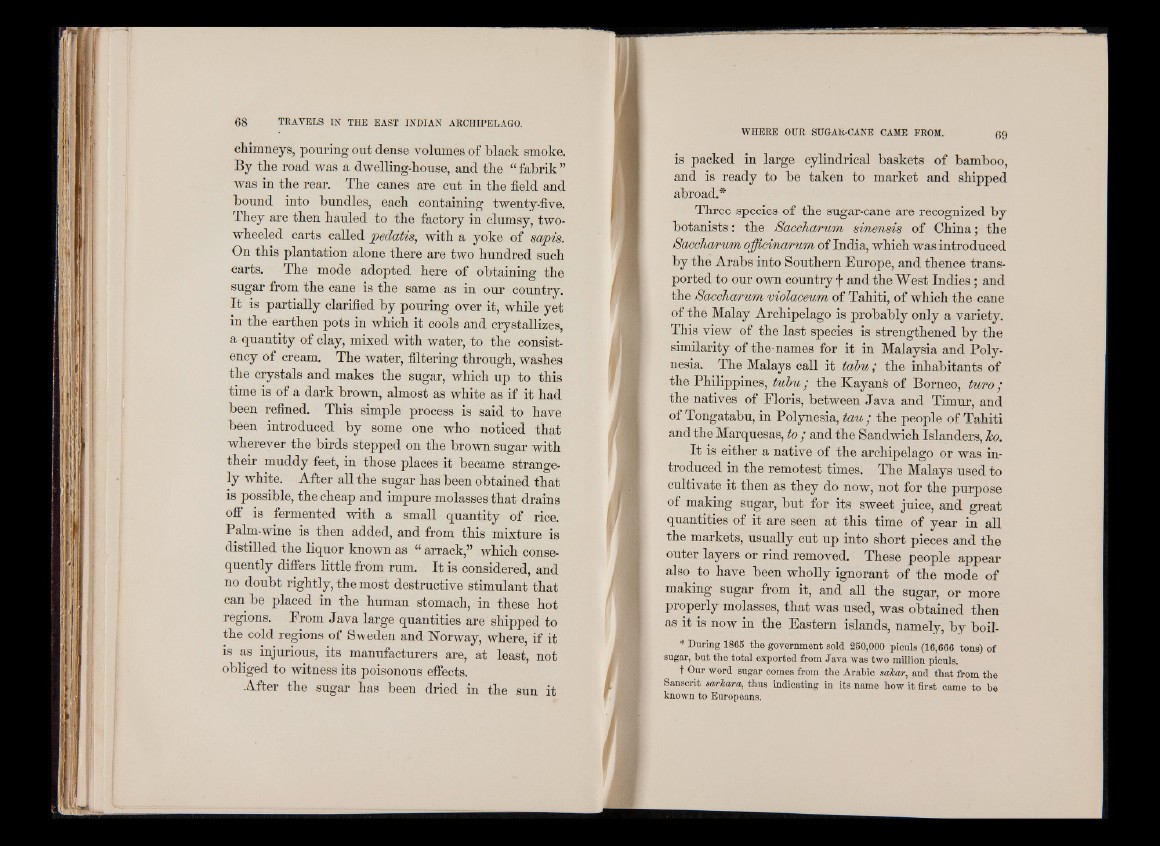
chimneys, pouring out dense volumes of black smoke.
By the road was a dwelling-house, and the “ fabrik ”
was in the rear. The canes are cut in the field and
bound into bundles, each containing twenty-five.
They are then hauled to the factory in clumsy, twowheeled
carts called pedatis, with a yoke of sapis.
On this plantation alone there are two hundred such
carts. The mode adopted here of obtaining the
sugar from the cane is the same as in our country.
It is partially clarified by pouring over it, while yet
in the earthen pots in which it cools and crystallizes,
a quantity of clay, mixed with water, to the consistency
of cream. The water, filtering through, washes
the crystals and makes the sugar, which up to this
time is of a dark brown, almost as white as if it had
been refined. This simple process is said to have
been introduced by some one who noticed that
wherever the birds stepped on the brown sugar with
their muddy feet, in those places it became strangely
white. After all the sugar has been obtained that
is possible, the cheap and impure molasses that drains
off is fermented with a small quantity of rice.
Palm-wine is then added, and from this mixture is
distilled the liquor known as “ arrack,” which consequently
differs little from rum. It is considered, and
no doubt rightly, the most destructive stimulant that
can be placed in the human stomach, in these hot
regions. From Java large quantities are shipped to
the cold regions of Sweden and Norway, where, if it
is as injurious, its manufacturers are, at least, not
obliged to witness its poisonous effects.
After the sugar has been dried in the sun it
WHERE OUR SUGAR-CANE CAME PROM. 69
is packed in large cylindrical baskets of bamboo,
and is ready to be taken to market and shipped
abroad.*
Three species of the sugar-cane are recognized by
botanists: the Saccha/rum sinensis of China; the
Saccha/rum officinarum of India, which was introduced
by the Arabs into Southern Europe, and thence transported
to our own country f and the West Indies; and
the Saccha/rum violaceum of Tahiti, of which the cane
of the Malay Archipelago is probably only a variety.
This view of the last species is strengthened by the
similarity of the-names for it in Malaysia and Polynesia.
The Malays call it tabu; the inhabitants of
the Philippines, tubu; the Kayans of Borneo, turo ;
the natives of Floris, between Java and Timur, and
of Tongatabu, in Polynesia, tarn; the people of Tahiti
and the Marquesas, to ; and the Sandwich Islanders, ho.
It is either a native of the archipelago or was introduced
in the remotest times. The Malays used to
cultivate it then as they do now, not for the purpose
of making sugar, but for its sweet juice, and great
quantities of it are seen at this time of year in all
the markets, usually cut up into short pieces and the
outer layers or rind removed. These people appear
also to have been wholly ignorant of the mode of
making sugar from it, and all the sugar, or more
properly molasses, that was used, was obtained then
as it is now in the Eastern islands, namely, by boil-
* During 1865 the government sold 250,000 piculs (16,666 tons) of
sugar, but the total exported from Java was two million piculs.
t Our word sugar comes from the Arabic saJcar, and that from the
Sanscrit sarhara, thus indicating in its name how it first came to be
known to Europeans.